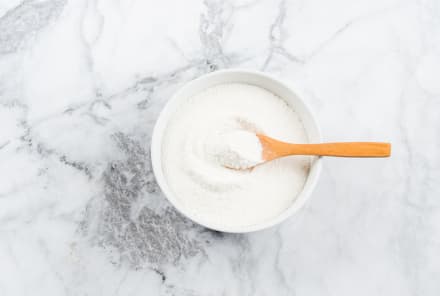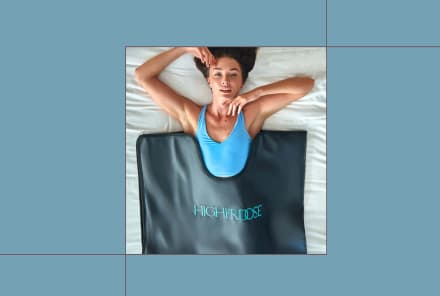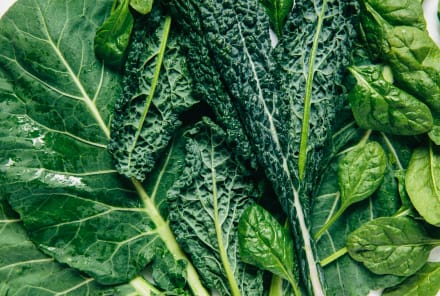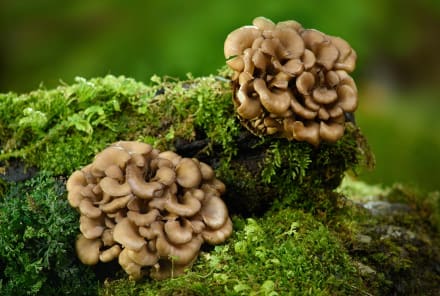Advertisement
Bentonite Clay: Benefits, Uses, Side Effects, DIY Masks & More


If you're the type of person who slathers activated charcoal on your face, you've certainly heard of bentonite clay (also known as calcium bentonite clay). This multipurpose powder—made from volcanic ash that's been aged in prehistoric sea beds—is an ingredient in everything from beautifying hair and face masks to tonics.
But does it actually work? History certainly makes a compelling case, as does some compelling research. While this is all encouraging, it still doesn't mean that bentonite clay delivers on every one of its head-to-toe, health-boosting claims or that it's safe to consume. So we dove into the research to help set the record straight.
What exactly is bentonite clay?
Bentonite clay is formed from ancient volcanic ash that was once exposed to seawater, at which point it absorbed a whole lot of minerals. It's often sourced from ancient seabeds (that are now dry land), and its name comes from Fort Benton, Montana—the location of the largest known deposit of bentonite clay. It's also called montmorillonite clay since this type of clay was first discovered in France's Montmorillon region.
There are two types of bentonite clay, depending on the ratio of key minerals they contain: sodium bentonite clay and calcium bentonite clay. They have similar properties, with subtle nuances.
"Both kinds can be used for facial masking," says Samantha Story of Studio Britta, a holistic skin care clinic in NYC. "Sodium bentonite draws more toxins out of the skin, and calcium bentonite is gentler and provides the skin with more minerals. While both types have their benefits, I prefer calcium bentonite for facial masks or using a mixture of the two for more congested skin."
Calcium bentonite clay, particularly green calcium bentonite clay, is also the type that's typically preferred for consumption (in small amounts, of course) when used for detoxification purposes, as it seems to be a bit gentler on the body.
While it may be relatively new to you, there's evidence that some of the earliest civilizations used clay to treat everything from aches and pains to infections and food poisoning. In ancient Mesopotamia1 (5000 to 3500 BCE), for instance, it's believed that people used a number of natural substances, including clays, to make poultices—mixtures of clay and water (or other wet ingredients like tea) wrapped in thin cloth and applied to the body to relieve pain and inflammation.
The benefits of bentonite clay.
Bentonite clay certainly has a history of medicinal uses, along with plenty of anecdotal accounts to suggest that it's effective for external and internal uses. But is there proof that it really works?
While human clinical trials are scarce, a few do exist, along with some impressive lab and animal research. It's important to note, however, that many of these findings need to be validated before they can become true recommendations. That said, here are some of the most promising potential benefits of bentonite clay to date:
It may help rid the body of heavy metals.
The basis for many of bentonite clay's proposed benefits is that it is highly adsorptive which makes it attract positively charged particles like a magnet, both when it's applied topically (that's why your face mask is so effective!) and when taken internally. What makes it so? The clay's particles carry a negative electric charge2. Heavy metals, and free radicals are said to carry a positive charge, and some research2 suggests that negatively charged bentonite is able to attach to these substances and help remove them from the body.
Some animal research does seem to support this. Bentonite clay could help bind aflatoxins in the body when ingested and reduce their toxicity, according to several animal feeding studies. If you're not familiar, aflatoxins are a family of cancer-causing toxins produced by fungi found on agricultural crops such as corn, peanuts, cottonseed, and tree nuts. People can be exposed by eating contaminated crops, and research shows that aflatoxin exposure is associated with an increased risk of liver cancer.
In one study3, adding bentonite clay to aflatoxin-contaminated corn partially restored pigs' liver function, and it did not impair their absorption of other minerals, and in another4, rabbits eating an aflatoxin-contaminated diet experienced an improvement in reproductive function once their feed was supplemented with bentonite.
Bentonite may hold promise for countering the negative effects of heavy metals, too. Heavy metals like arsenic, cadmium, lead, and mercury can wreak havoc on our bodies, leading to everything from exhaustion to serious diseases. Too much cadmium, for example, has been linked to kidney disease, osteoporosis, and cardiovascular disease.
But in one study5, feeding pigs montmorillonite clay (the same as bentonite clay) for 100 days reduced the concentration of lead in their blood, brain, liver, bone, kidneys, and hair. Similar findings6 were made with carp, too—exposing them to cadmium caused oxidative stress, but supplementing their diet with clay reversed oxidative damage to the liver and kidneys.
Of course, humans aren't animals, but the fact that bentonite clay has similar toxin-removing effects among various species—without compromising the absorption of other minerals—is certainly intriguing.
It may promote good digestion.
Anecdotes of bentonite's digestion-regulating effects abound, with people taking it to treat everything from acid reflux to constipation to bloating and gas—which kind of makes sense once you realize that kaolin (another type of clay) was once commonly used in stomach-soothing meds like Rolaids and Maalox.
In particular, bentonite clay may hold promise for people suffering from irritable bowel syndrome (IBS). In one small clinical trial7, patients with constipation-predominant IBS who took 3 grams (a bit less than a teaspoon) of bentonite clay twice a day for eight weeks experienced improvements in bowel movements compared to a placebo group. No reduction in pain was noted, however.
It's not clear why exactly bentonite exerts positive effects on the digestive system, but some speculate that a reduction in IBS may be due to improvements in the health of the gut lining. There's also some evidence in animals that bentonite clay has anti-parasitic properties8, which could potentially ease stomach woes. Benefits, like heartburn relief, have more obvious explanations—the minerals in bentonite clay, including calcium and magnesium, have acid-neutralizing properties.
All that said, however, there's still no clear consensus on whether we should actually be consuming bentonite clay.
It may help fight off serious bacterial infections like MRSA.
Serious bacterial infections like MRSA—a form of staph that's resistant to many forms of antibiotics—are no joke. It can cause problems ranging from skin infections and sepsis to pneumonia to bloodstream infections, according to the CDC9. But bentonite clay may help where conventional medicine cannot.
Scientists at Arizona State University wanted to test out the antibacterial potential of smectite clay minerals10 (a group that encompasses bentonite clay) on a variety of bacteria that were both resistant and nonresistant to antibiotics. When they exposed this bacteria to the clay minerals in the lab, the clay exhibited antibacterial properties that were effective at killing MRSA, various types of E. coli, and Salmonella. While the researchers haven't pinpointed the mechanism by which clay kills bacteria, they do believe it holds promise for the development of treatments to fight antibiotic-resistant infections.
It's been shown to soothe and protect skin.
Throughout history, clay's predominant medical uses have been topical—like slapping some wet clay mud onto a bug bite, weird rash, or infection. And, it turns out, research confirms bentonite's protective and soothing properties.
In one study, a lotion containing bentonite clay was shown to be effective at preventing or reducing the severity of poison ivy11 when applied to skin before coming into contact with poison ivy's itch-inducing compound urushiol. The same lotion featuring bentonite effectively treated chronic dermatitis12 (irritated and inflamed skin, like eczema).
Bentonite holds promise as a diaper rash treatment, too—one study found that a bentonite diaper cream acted better and faster than a calendula diaper cream13. Within the first six hours, 88 percent of the skin lesions in the bentonite group started improving, while only 54 percent started improving in the calendula group.
The reasons for these benefits aren't exactly clear, but they may have to do with the fact that bentonite clay particles form a physical barrier that protects the skin or that clay can absorb a significant amount of water and be an effective way of drawing out skin-irritating substances. The minerals in bentonite clay may also have skin-soothing properties.
It may improve the appearance of skin and hair.
Beyond healing irritating rashes, bentonite offers up some beautifying perks for your skin. If you've ever used a clay mask, you know firsthand the oil-sucking, pore-clearing powers of this mineral-rich sludge, which seems to draw out every impurity from your face.
But in addition to removing dirt, excess oil, and other skin saboteurs, bentonite may work its magic on your mug in another way—by boosting collagen production. In a small animal study, a daily application of bentonite clay to the skin increased the number of collagen fibers14 after just seven days. This may be due to bentonite's high levels of the mineral silica, which helps maintain healthy connective tissue. While this collagen-boosting benefit hasn't been established in humans, it's certainly promising enough to consider a bentonite face mask.
Bentonite seems to have potent skin-clarifying benefits, too. A study on men and women with mild acne found that a mask of jojoba oil and bentonite clay—applied two or three times a week for six weeks—was effective at reducing the number of acne lesions15 by an average of 54 percent.
Bentonite may even improve the look and feel of your hair. Countless natural beauty bloggers swear by bentonite clay hair masks, as the clay supposedly moisturizes and draws out excess dirt and oil simultaneously. While there haven't been studies on this, bentonite clay is used in various parts of the world16 to cleanse and soften hair.
How to use bentonite clay for skin, hair, and health.
A quick Google search reveals countless ways to use bentonite clay to reap its skin, hair, immune-boosting, and detoxifying perks. But we've pared down the list for you. Before you dive in, just keep in mind that most brands recommend mixing your clay and liquid solutions in a glass or ceramic bowl with a wooden or plastic spoon, as metal may react with clay and minimize its benefits.
Another pro tip: While bentonite clay is sold as a powder, you may want to keep a jar of paste on hand, since several of the uses below call for a paste. According to Redmond Clay, you can do this by combining 1 part bentonite clay with 2 parts water in a Mason jar and mixing or shaking well.
Now, here are some of our favorite bentonite clay uses for health and beauty:
Soothing skin paste
For minor burns, bug bites, and rashes, combine bentonite clay with water to your desired thickness (a water-to-clay ratio of 1:1 or 2:1 is usually good), then slather onto skin. Leave the paste on until it dries, and wash off when you're done.
Armpit mask
We know, this one might sound a little crazy, but armpit detoxes are a thing now. The idea is that most conventional deodorants are loaded with aluminum and other ingredients that prevent you from sweating, which interferes with one of your body's most natural detox mechanisms. Applying a paste of bentonite clay and water to your pits (with the consistency of yogurt), however, helps pull some of these potentially harmful substances from your skin.
"As bentonite clay draws out heavy metals, it frees up the lymphatic system, a key component to good health," says Story. "We have lymph nodes in our armpits as well as detoxifying sweat glands, making this a great place to aid lymphatic drainage by doing an underarm mask. If you're considering switching to natural deodorants I recommend this mask to aid in the transition as it helps restore a healthy pH and a more pleasant odor."
Nourishing face mask
You can simply combine bentonite clay and water to form a paste and spread over your face, but for a boost of hydration, Story recommends a combination of 1 teaspoon bentonite clay, 1 teaspoon Manuka honey, and enough water to create a paste. Leave it on for 15 to 20 minutes; remove it when it begins to feel tight (don't let it dry on your skin). Hydrate and moisturize right when you're done.
Clarifying hair mask
If you want a more natural approach to hair care, especially if your strands tend to be on the oilier side, consider applying a bentonite hair mask once or twice a week. Many recipes call for this combination: 1 cup clay, 1 cup water, and ½ cup apple cider vinegar. Mix it all up and slather on your strands from root to tip. Several beauty bloggers claim that it helps with curl definition as well.
Skin-softening clay bath
To reap the skin-soothing benefits of bentonite clay from head to toe, add ¼ cup of bentonite powder, 1 cup of Epsom salts, and a few drops of your favorite essential oils to warm bath water. "The heat boosts the circulatory system, and the clay draws toxins out of the body," says Story. The magnesium in the clay and Epsom salts helps promote relaxation. "These baths can be intense," cautions Story, "so make sure to hydrate and listen to your body in terms of how long is right for you."
Soothing foot soak
Not up for a whole bath? Fill up a bucket with warm water and a couple of tablespoons of bentonite clay, and give your feet a good soak. Not only will your feet feel softer, but the magnesium content in clay can do wonders for sore feet (just like Epsom salts).
Tooth-brushing powder
Ever hear of The Dirt? It's a trace mineral tooth-brushing powder featuring extra-fine bentonite clay along with essential oils for flavor. Because of clay's naturally abrasive and antibacterial properties, it may be able to make those pearly whites shine even brighter. If you want to go the DIY route, simply dip your wet toothbrush in bentonite clay powder and start brushing. Consult with your dentist first if you have any concerns.
Potential bentonite clay dangers: Are there side effects?
Let's get one thing straight: Bentonite clay naturally contains trace amounts of heavy metals, including lead. While it sounds scary, the amounts found in bentonite clay products sold to consumers are likely too low to cause problems. Levels per 1-teaspoon serving of clay are typically lower than those you'd find in a serving of some vegetables and plant foods, like sweet potatoes or mixed nuts, due to the natural presence of lead in soil.
Additionally, the lead present in bentonite clay is bonded to other molecules, which means it may actually be safer than the isolated forms of lead you'd find in lead paint or contaminated cosmetics. One brand describes it this way: "The lead atoms in bentonite clay are so tightly bound in a matrix with other atoms that they do not break away from this matrix as the clay travels through your body or interacts with your skin. In fact, these clay molecules have an unusually large surface area with such a strong negative charge, they act like a strong magnet to draw the positively charged lead out of your body."
While that claim may sound self-promotional, animal research does seem to support it. Remember the pig study5 mentioned above? It found that feeding the pigs montmorillonite clay (the same as bentonite clay) for 100 days reduced the concentration of lead in their blood, brain, liver, bone, kidneys, and hair.
Even so, there have still been some scares—in 2016, the U.S. Food & Drug Administration warned consumers17 not to purchase the small brand Best Bentonite Clay due to elevated lead levels. This means it's extremely important to purchase a clay sold by a reputable brand that has ideally done an elemental analysis of their product to ensure safe lead levels (if you don't see one on their website, you can request one).
Bottom Line
While the consensus on whether or not you should ever consume bentonite clay is still pretty iffy (if you're at all tempted, always consult with your doctor first), topical use of bentonite clay appears to be quite safe. But, of course, if you experience skin irritation, discontinue use.
17 Sources
- https://www.ncbi.nlm.nih.gov/pmc/articles/PMC1437561/?page=2
- https://www.ncbi.nlm.nih.gov/pmc/articles/PMC2895274/
- https://www.ncbi.nlm.nih.gov/pubmed/8099347
- https://www.ncbi.nlm.nih.gov/pubmed/23605531
- https://www.ncbi.nlm.nih.gov/pubmed/18568297
- https://www.ncbi.nlm.nih.gov/pubmed/20532670
- https://www.ncbi.nlm.nih.gov/pubmed/15709995
- https://www.ncbi.nlm.nih.gov/pubmed/1429295
- https://www.cdc.gov/mrsa/
- https://www.ncbi.nlm.nih.gov/pmc/articles/PMC2413170/
- https://www.ncbi.nlm.nih.gov/pubmed/7622647
- https://www.ncbi.nlm.nih.gov/pubmed/11685665
- https://www.ncbi.nlm.nih.gov/pmc/articles/PMC4774071/
- https://www.ncbi.nlm.nih.gov/pubmed/22340693
- https://www.ncbi.nlm.nih.gov/pubmed/22585103
- https://www.ncbi.nlm.nih.gov/pmc/articles/PMC5632318/
- https://www.fda.gov/Drugs/DrugSafety/ucm491396.htm
Watch Next
Enjoy some of our favorite clips from classes
Enjoy some of our favorite clips from classes
What Is Meditation?
Mindfulness/Spirituality | Light Watkins
Box Breathing
Mindfulness/Spirituality | Gwen Dittmar
What Breathwork Can Address
Mindfulness/Spirituality | Gwen Dittmar
The 8 Limbs of Yoga - What is Asana?
Yoga | Caley Alyssa
Two Standing Postures to Open Up Tight Hips
Yoga | Caley Alyssa
How Plants Can Optimize Athletic Performance
Nutrition | Rich Roll
What to Eat Before a Workout
Nutrition | Rich Roll
How Ayurveda Helps Us Navigate Modern Life
Nutrition | Sahara Rose
Messages About Love & Relationships
Love & Relationships | Esther Perel
Love Languages
Love & Relationships | Esther Perel
What Is Meditation?
Box Breathing
What Breathwork Can Address
The 8 Limbs of Yoga - What is Asana?
Two Standing Postures to Open Up Tight Hips
How Plants Can Optimize Athletic Performance
What to Eat Before a Workout
How Ayurveda Helps Us Navigate Modern Life
Messages About Love & Relationships
Love Languages
Advertisement

Want To Be Metabolically Healthy? New Study Shows An Underutilized Approach
Molly Knudsen, M.S., RDN
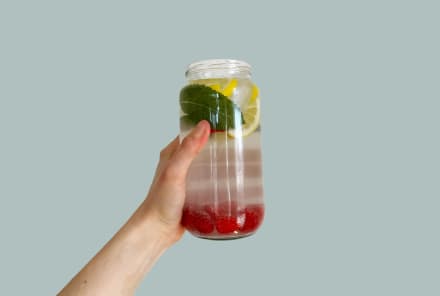
Bounce Back Quickly After Workouts With This DIY Electrolyte Drink
Molly Knudsen, M.S., RDN

Want To Be Metabolically Healthy? New Study Shows An Underutilized Approach
Molly Knudsen, M.S., RDN

Bounce Back Quickly After Workouts With This DIY Electrolyte Drink
Molly Knudsen, M.S., RDN
